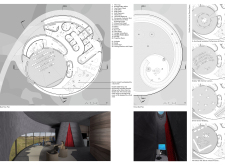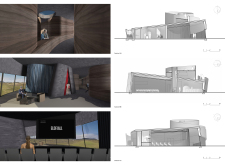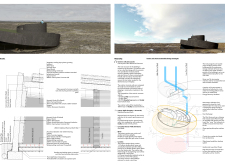5 key facts about this project
The Endalaus project serves as a cultural pavilion and movie theater situated in the distinctive landscape of Iceland. Designed to harmonize with its surroundings, the architecture employs a circular form that allows for an efficient spatial arrangement and enhances the user's experience with nature and the built environment. The intention behind this project is to foster community engagement and provide a versatile space that can adapt to various events and activities, such as film screenings, workshops, and social gatherings.
The primary architectural elements include a main auditorium, ancillary spaces, and communal areas. The circular layout facilitates fluid movement while encouraging interaction between visitors. This design minimizes exposure to harsh winds common in the region, and the sunken morphology creates an intimate environment that invites exploration.
Sustainable design strategies are central to the project, ensuring that the architecture responds to local climate conditions. A geothermal heating system prioritizes energy efficiency, and rainwater harvesting elements contribute to responsible water management. The green roof enhances insulation while promoting local biodiversity—which aligns with the broader environmental goals of the project.
Innovative Material Use and Sustainability
One of the defining features of the Endalaus project is its selection of materials, each chosen for their durability and environmental performance. Cast-in-place fiber-reinforced concrete forms the structural walls, providing stability in the face of seismic activity and harsh weather conditions. Inside, rammed earth walls create intimate spaces that also contribute to thermal mass, ensuring comfort throughout the year.
Acoustic panels have been incorporated to improve sound quality in the theater and exhibition areas. Local stone wool insulation complements the building's thermal strategy, contributing to energy efficiency without compromising on aesthetics. Sustainable timber finishes introduce organic warmth and connect the interiors to their natural setting.
Adaptability in Design
The flexibility inherent in the architectural design allows for a range of programming options. The auditorium can be configured for different audience sizes and purposes, ensuring that the space can evolve to meet the community's changing needs. This adaptability is significant in promoting usage across various events, making the pavilion a vital part of the local cultural landscape.
The thoughtful articulation of spaces within the project demonstrates a clear understanding of user experience while prioritizing functionality. The circular design not only enhances visual connections to the landscape but also allows for unobstructed views from multiple vantage points.
Endalaus stands out within the context of contemporary architecture by addressing environmental sustainability and human-centered design principles. Its integration into the Icelandic topography and climate reflects a broader commitment to architecture that is considerate of both ecological and social factors.
To explore the nuances of the Endalaus project further, including architectural plans, sections, and design concepts, readers are encouraged to review the detailed project presentation. These insights will provide a deeper understanding of the architectural ideas that shape this unique cultural space.


























